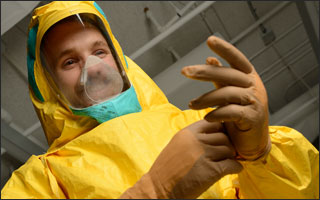Between the euphoria of winning an international design competition and seeing a useful product in the hands of health care workers comes a period filled with hard work, engineering challenges, scale-up and financial issues. No one knows this better than Youseph Yazdi, PhD, an assistant professor of biomedical engineering and executive director of the Johns Hopkins Center for Bioengineering Innovation and Design (CBID) in the Department of Biomedical Engineering.
Yazdi and his colleagues at CBID and Jhpiego, an affiliate of JHU, last October led a team of Johns Hopkins students, staff, faculty and friends in an intense weekend of reimagining the protective gear worn by medical professionals treating patients in an Ebola-like epidemic.
“We brought in experts to help our design teams understand the problem and context. They heard about the brave frontline health workers dying from infections that were sometimes the result of flaws in their protective suits, which are unbearably hot and difficult to remove safely and quickly. The teams focused on addressing those and other challenges,” Yazdi says.
They generated over 100 ideas and submitted a mashup of these to USAID’s global design competition Fighting Ebola: A Grand Challenge for Development. Yazdi was surprised to hear that out of over 1,500 entries, the Johns Hopkins design was one of five winners.
Among the greatest challenges was designing an inexpensive and effective cooling mechanism for the suit, which heats up quickly in the sweltering climes of West Africa. The JHU submission to the challenge uses a ventilating system that dehydrates the inbound air by drawing it in through a desiccant. This idea is based on the research of Dr. Hari Tandri, a JHMI cardiologist interested in brain cooling. “We found that simply breathing dried air makes the wearer much more comfortable,” Yazdi explains.
The new suit is also designed to be within 20 percent of the cost of existing products. “If you design a solution that costs $500 per suit, you haven’t really solved the problem,” he says. “Engineering design is iterative. You assess, design, build, evaluate repeatedly. Most initial ideas take many iterations of refinement to actually be useful.”
Yazdi says the team has a working design and is engaging a major protective suit manufacturer to license it and have product available by summer. “This Ebola outbreak killed over 10,000 people, many more than prior outbreaks. The world can’t afford to get caught flat-footed when the next infectious disease outbreak hits, and this new protective suit will help us be better prepared and protect the brave men and women at the front lines of the response,” Yazdi says.
— Andrew Myer

